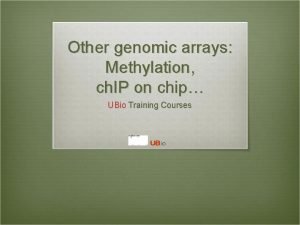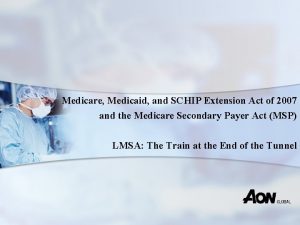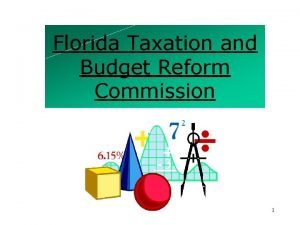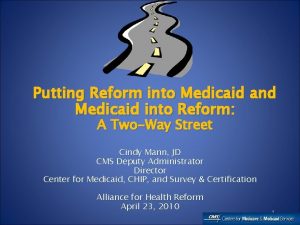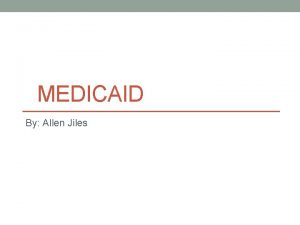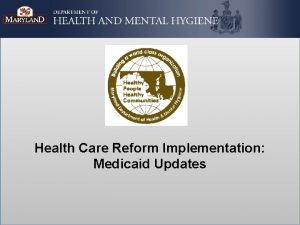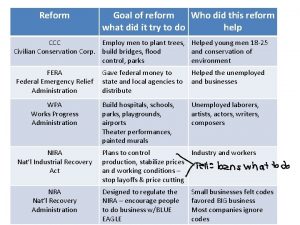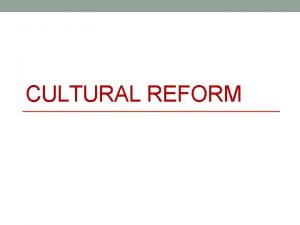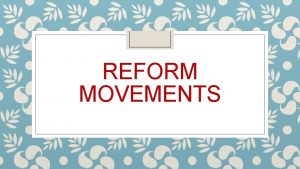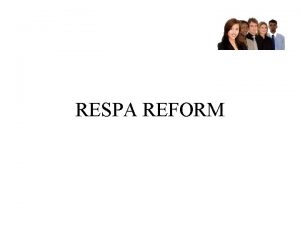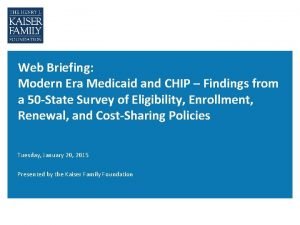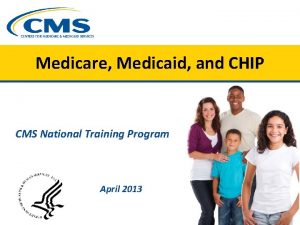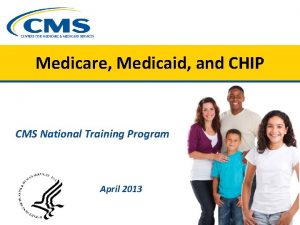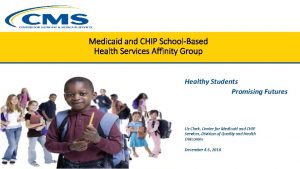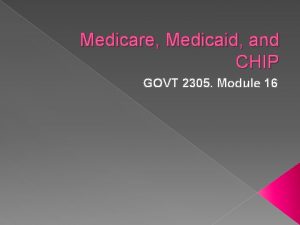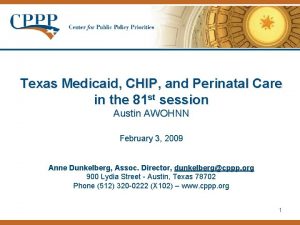Medicaid and CHIP On the Road to Reform

















- Slides: 17

Medicaid and CHIP: On the Road to Reform Cindy Mann, JD CMS Deputy Administrator Director Center for Medicaid, CHIP and Survey & Certification Centers for Medicare & Medicaid Services Alliance for Health Reform/Kaiser Family Foundation March 4, 2011

Implementing the Affordable Care Act v Working with States (Governor’s offices, Medicaid, CHIP, Insurance Commissioners) v Coordinating with the Center for Consumer Information and Insurance Oversight (CCIIO), IRS/Treasury, other federal agencies v Listening to what reform means to a broad array of stakeholders v Promulgating regulations and guidance; providing technical assistance 2

Sources of Coverage by 2019 for Individuals Under 65 23 m 24 m 25 m 159 m Source: Congressional Budget Office, March 2010 51 m

New Paradigm v Not a safety net but a full partner in assuring coverage, quality and cost containment v Simplified rules and process (eligible = enrolled) v A system of coverage and care Medicaid/ CHIP Employer Coverage Exchange

Percentage of Population Under 133% of the FPL Uninsured vs. Medicaid Covered 66% 42% 43% 35% 23% 17 % Source: HHS ASPE analysis of the 2010 Annual Social and Economic Supplement to the Current Population Survey

Minimum Medicaid Eligibility Levels Now and 2014 Population Current Minimum Eligibility Levels (average) 2014 Minimum Eligibility Levels Children 100%/133% (241%) 241% Average - Will vary by State Parents 41% (64%) 133% Disabled Adults 74% (SSI-related) 133% Other Adults 0%* 133% * 5 States provide Medicaid or Medicaid look-alike coverage to certain childless adults; 15 States provide a limited benefit package to certain childless adults.

2014 Health Insurance Subsidies 400% FPL 241% FPL 133% FPL 0 Exchange Subsidies Varies by State Medicaid/CHIP Children Medicaid Adults Children

First Steps: Modernized, Efficient Systems v IT Guidance 1. 0 for Medicaid and the Exchange v NPRM on Medicaid Eligibility Systems ü 90% FFP for eligibility and enrollment system design and development until 12/31/15 ü 75% FFP for system maintenance ü Established 7 Conditions & Standards v 7 Exchange Innovator Grants and Collaborative 8

Who Pays? Estimated Distribution of Costs for Medicaid Coverage Changes: 2014 -2019 (in billions) Total $464. 7 billion Source: Congressional Budget Office and Medicaid Coverage and Spending in Health Reform, John Holahan and Irene Headen/Kaiser Commission, May 26, 2010

Current Fiscal Pressures v Enrollment among families and children has grown sharply due to the recession v Medicaid is intended to be a countercyclical program v Despite enrollment growth, state Medicaid spending declined during the recession v The Recovery countercyclical FMAP increase resulted in a 10% drop in state spending on Medicaid in 2009 v While enrollment growth explains recent growth in costs, the real cost drivers lie elsewhere 10

Concentration of Medicaid Spending 1% 5% 54% Percentile of Medicaid Population (Ranked by Spending) 10% Percent of Total Medicaid Spending 95% 5% 0% 50% 20% Source: Medicaid Statistical Information System Claims Data for FY 2008 40% 60% 80% 100%

Coverage: Pathway to Better Care, Better Health, Lower Costs Population Health Experience Of Care Per Capita Cost

What CMS is Doing to Help States Reduce Costs Now v Focus on Medicaid Cost Drivers v Existing Authority & New Initiatives ü Benefits & Cost-Sharing ü Integrated Care for High-Cost Beneficiaries; improving care transitions; reducing unnecessary hospitalizations ü Purchasing Drugs More Efficiently ü Assuring Program Integrity v Working individually with States (“MSTAT”)

Health Care Expenditures $7, 464 Average Cost of One Hospital Admission for a Non-Dual Disabled Medicaid Enrollee Annual Cost of Providing Health Coverage to One Parent under Medicaid Source: CMS data analysis and Urban Institute analysis of data from MSIS and CMS Form 64, prepared for Kaiser Commission on Medicaid and the Uninsured, 2010. Kaiser Family Foundation-State Health Facts, FY 2007.

Focus on Dual Eligibles Duals as Share of Medicaid Spending 61% 39% Dual Eligibles Non-Duals Total Spending = $311 billion Children Source: CMS data and Urban Institute analysis of data from MSIS and CMS Form 64, prepared for Kaiser Commission on Medicaid and the Uninsured, 2010. Kaiser Family Foundation-State Health Facts, FY 2007. Non-Disabled Adults Duals

Achieving a High Performing Medicaid Program States and the Federal Government working together to achieve: v Simplified, accurate, customer-friendly, data driven eligibility/renewal processes that are fully coordinated with the Exchange § Eligible = Enrolled v Access to person-centered, high quality, integrated care with options for continuity of coverage with plans on the Exchange v Continuing quality and cost improvement in our health care system, based on consumer and other stakeholder input, data, and collaboration.

High Performing Medicaid Program
 Methylation & chip-on-chip microarray platform
Methylation & chip-on-chip microarray platform Paved road vs unpaved road
Paved road vs unpaved road Mmsea act of 2007
Mmsea act of 2007 Democratic reform and activism
Democratic reform and activism Chapter 10 section 1 democratic reform and activism
Chapter 10 section 1 democratic reform and activism Chapter 23 lesson 3 nationalism unification and reform
Chapter 23 lesson 3 nationalism unification and reform The ferment of reform and culture
The ferment of reform and culture Revolution brings reform and terror
Revolution brings reform and terror Taxation and budget reform commission
Taxation and budget reform commission Fdr three rs
Fdr three rs Chapter 19 political reform and the progressive era
Chapter 19 political reform and the progressive era Chapter 15 the ferment of reform and culture
Chapter 15 the ferment of reform and culture What was reform darwinism?
What was reform darwinism? Chapter 7 section 2 revolution brings reform and terror
Chapter 7 section 2 revolution brings reform and terror Chapter 15 the ferment of reform and culture
Chapter 15 the ferment of reform and culture W.w. norton
W.w. norton Chapter 23 section 2 revolution brings reform and terror
Chapter 23 section 2 revolution brings reform and terror The ferment of reform and culture
The ferment of reform and culture
